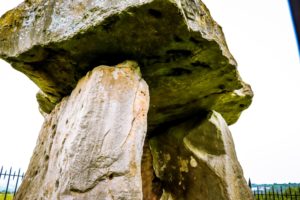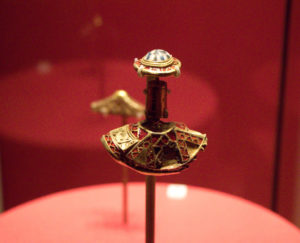Goodrich Castle is a Norman medieval castle ruin north of the village of Goodrich in Herefordshire, England, controlling a key location between Monmouth and Ross-on-Wye. It was praised by William Wordsworth as the “noblest ruin in Herefordshire” and is considered by historian Adrian Pettifer to be the “most splendid in the county, and one of the best examples of English military architecture”.
Goodrich Castle was probably built by Godric of Mappestone after the Norman invasion of England, initially as earth and wooden fortification. In the middle of the 12th century, the original castle was replaced with a stone keep and was then expanded significantly during the late 13th century into a concentric structure combining luxurious living quarters with extensive defenses. The success of Goodrich’s design influenced many other constructions across England over the following years. It became the seat of the powerful Talbot family before falling out of favor as a residence in late Tudor times.
Held first by Parliamentary and then Royalist forces in the English Civil War of the 1640s, Goodrich was finally successfully besieged by Colonel John Birch in 1646 with the help of the huge “Roaring Meg” mortar, resulting in the subsequent slighting of the castle and its descent into ruin.
Goodrich Castle appears to have been in existence by 1101, when it was known as Godric’s Castle, named probably after Godric of Mappestone, a local Anglo-Saxon thane and landowner mentioned in the Domesday Book of 1086. Victorian historians, however, believed the castle to date back further to the pre-Norman conquest days of King Canute, and the site may have been among a small number of Saxon fortifications along the Welsh border. By Norman times, Goodrich formed part of the Welsh Marches, a sequence of territories granted to Norman nobles in, and alongside, Wales. Although Goodrich lay on the safer, English side of the border, the threat of raids and attacks continued throughout most of the period.
During the 12th century the attitudes of the English nobility towards the Welsh began to harden; the policies of successive rulers, but especially Henry II, began to become more aggressive in the region. In the mid-12th century, Godric’s original earth and timber fortification was dismantled and replaced by a tall but relatively small square keep built of stone, sometimes known as “Macbeth’s Tower”. The keep was designed to be secure and imposing but relatively cheap to build. It is uncertain, however, precisely who was responsible for this rebuilding or the date of the work, which may have been between 1120 and 1176.
At the beginning of the 12th century, the castle had passed from Godric to William Fitz Baderon, thought to be his son-in-law, and on to his son, Baderon of Monmouth, in the 1120s. England descended into anarchy, however, during the 1130s as the rival factions of Stephen and his cousin Empress Matilda vied for power. Baderon of Monmouth married Rohese de Clare, a member of the powerful de Clare family who usually supported Stephen, and there are records of Baderon having to seize Goodrich Castle during the fighting in the region, which was primarily held by supporters of Matilda. Some suspect that Baderon may have therefore built the stone keep in the early years of the conflict. Stephen went on, however, to appoint Baderon’s brother-in-law, Gilbert de Claire, the Earl of Pembroke, and Gilbert de Clare eventually acquired Goodrich Castle himself. Gilbert’s son, Richard de Clare, known as “Strongbow”, succeeded him in 1148, and Richard is another candidate for the construction of the keep. In 1154 Richard fell out of favor with King Henry II because of the de Clares’ support for Stephen, and the castle was taken into royal hands. Some argue that the king himself may have ordered the construction of the great keep.
During the following reigns of King Richard I and his brother John, the castle and manor were held by the Crown. King John, however, lost many of his lands in France which in turn deprived key English nobles of their own estates – John became concerned about possible opposition to his rule. Accordingly, in 1203 John transferred Goodrich Castle and the surrounding manor to William Marshal, Earl of Pembroke, to partially compensate him for his lost lands on the continent. Marshal was a famous English knight with a reputation as a heroic warrior, and he expanded Goodrich by building an additional towered curtain wall in stone, around the existing keep. Marshal had to intervene to protect Goodrich Castle from Welsh attack, most famously in 1216 when he was obliged to leave Henry III’s coronation feast in Gloucester to hurry back to Goodrich to reinforce the castle.
Marshal’s sons inherited the castle after their father’s death; Marshal left the castle to his eldest son, William, who in turn gave it to his younger brother, Walter.[32] After William’s death, however, Marshal’s second son, Richard, took over the castle. Richard led the baronial opposition to Henry III and allied himself with the Welsh, resulting in King Henry besieging Goodrich Castle in 1233 and retaking personal control for a period. Walter was eventually given Goodrich back once more but died shortly afterward in 1245.
The castle briefly reverted to the Crown again, but in 1247 passed by marriage to William de Valence, half brother to Henry III. De Valence was a French nobleman from Poitiers and a noted soldier who spent most of his life-fighting in military campaigns; Henry arranged his marriage to Joan de Munchensi, one of the heiresses to the Marshal estate. The marriage made Valence immensely rich and gave him the title of Earl of Pembroke.
The Welsh border situation remained unsettled, however, and in the decades after 1250 security grew significantly worse, as the Welsh prince Llywelyn ap Gruffudd conducted numerous raids into English territories. The Wye Valley and Goodrich were particularly affected by these raids.
Accordingly, William de Valence began to build a much larger castle around the original keep from the 1280s onwards, demolishing Marshal’s earlier work. As part of the extremely expensive construction work, Valence used oak trees drawn from several royal forests. Valence was building at the same time that his nephew Edward I was constructing his major castles in the north of Wales, and the concentric castle that he built at Goodrich are both very similar in design and a rarity in England itself. Valence’s son, Aymer de Valence built an additional line of outer defenses before his death in 1324, including the external barbican, inspired by that at the Tower of London, and for which the earlier Valence barbican at Pembroke may have been an experimental forerunner. The effect was an early success in converting a fortress into a major dwelling, without damaging its defensive arrangements, and influenced the later castle conversion at Berkeley.
The castle then passed to Aymer’s niece, Elizabeth de Comyn, a well-connected young noblewoman. By the middle of the 1320s, however, England was in the grip of the oppressive rule of the Marcher lords Hugh le Despenser the older and his son Hugh Despenser the younger, the royal favorites of King Edward II. As part of a “sweeping revenge” on their rivals, especially in the Marches, the Despensers illegally seized a wide range of properties, particularly from vulnerable targets such as widows, wives whose husbands were out of favor with the king, or unmarried women. Upon her inheritance, Hugh le Despenser the younger promptly kidnapped Elizabeth in London and transported her to Herefordshire to be imprisoned in her own castle at Goodrich. Threatened with death, Elizabeth was finally forced to sign over the castle and other lands to the Despensers in April 1325. Elizabeth then married Richard Talbot, the 2nd Baron Talbot, who seized back the castle in 1326 shortly before Queen Isabella of France landed in England and deposed both the Despensers and her husband Edward II; Talbot and Elizabeth regained their legal title to the castle the following year. Richard later received permission from Isabella’s son Edward III to create a dungeon under the keep for holding prisoners.









